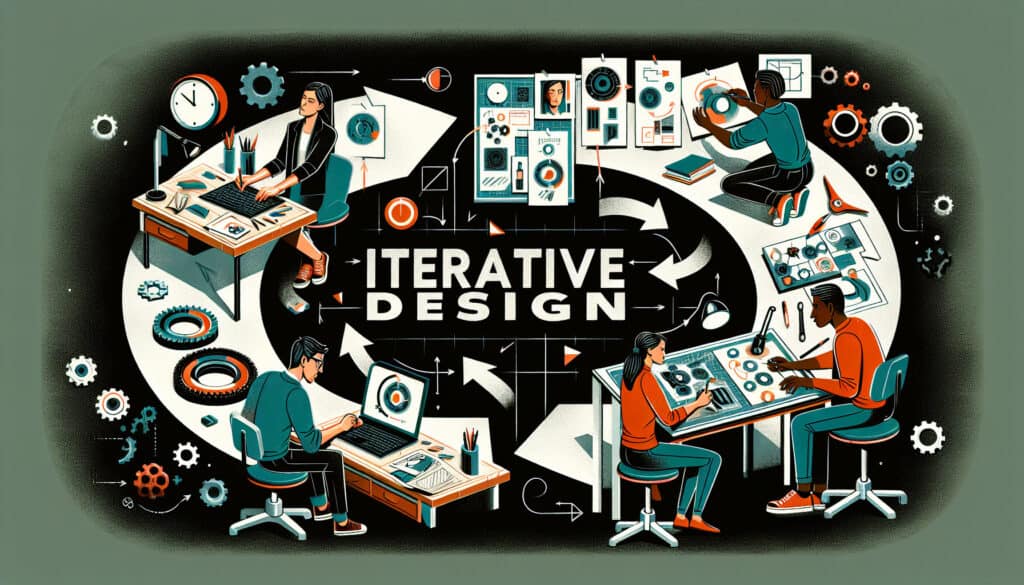A design methodology based on a cyclic process of prototyping, testing, analyzing, and refining a product or process.
- Méthodologies : Clients et marketing, Économie
Iterative Design

Iterative Design
- Méthodologie Agile, Amélioration continue, Processus de conception, Examen de la conception, Pensée conceptuelle, Développement itératif, Prototypage, User-Centered Design
Objectif :
Comment il est utilisé :
- A design process that involves creating a series of prototypes that are tested and refined in a cyclical manner. This allows designers to get feedback from users early and often, and to make improvements to the design throughout the development process.
Avantages
- Allows for flexibility and adaptation throughout the design process; Reduces the risk of failure by getting feedback early and often.
Inconvénients
- Can be time-consuming and may not be suitable for projects with tight deadlines; Can lead to scope creep if not managed carefully.
Catégories :
- Ingénierie, Conception de Produits
Idéal pour :
- Developing new products and services in a flexible and centré sur l'utilisateur way.
Iterative Design is particularly beneficial in industries such as consumer electronics, automotive, software development, and healthcare, where rapid technological advancements and user preferences are constantly evolving. This methodology is typically employed during the product development phase, where designers and engineers collaborate with end-users to create multiple versions of a product, each refined based on user feedback, usability studies, and testing results. By initiating this process, cross-functional teams including designers, product managers, engineers, and marketing representatives s'engager in brainstorming sessions that encourage creative solutions to user problems. For example, in software development, beta testing phases are a form of Iterative Design where software can undergo multiple rounds of revisions based on user interactions, ultimately leading to a more polished final product. In the consumer electronics sector, companies like Pomme and Samsung often release prototypes to small user groups to gather detailed feedback on design, functionality, and user experience before launching the final version. This approach not only accelerates innovation but also minimizes the risk of market failure since real user expectations and experiences are considered in each iteration, allowing teams to pivot quickly in response to feedback without substantial resource investment in a single untested design.
Principales étapes de cette méthodologie
- Define user needs and requirements based on stakeholder input.
- Sketch initial design concepts that address user needs.
- Create low-fidelity prototypes to visualize concepts.
- Conduct usability testing with target users on prototypes.
- Gather user feedback and identify areas for improvement.
- Refine design based on feedback and insights.
- Develop higher-fidelity prototypes incorporating revisions.
- Repeat usability testing with updated prototypes.
- Continue iterating until user satisfaction and design goals are met.
Conseils de pro
- Incorporate user personnes into your prototypes to address specific needs and preferences of different user segments.
- Utilize A/B testing on design variations to gather comparative data and make informed decisions based on user behavior.
- Implement rigorous documentation at each iteration to track changes, decisions, and user feedback systematically, facilitating later phases of development.
Lire et comparer plusieurs méthodologies, nous recommandons le
> Référentiel méthodologique étendu <
ainsi que plus de 400 autres méthodologies.
Vos commentaires sur cette méthodologie ou des informations supplémentaires sont les bienvenus sur le site web de la Commission européenne. section des commentaires ci-dessous ↓ , ainsi que toute idée ou lien en rapport avec l'ingénierie.
Contexte historique
1949
1950
1950
1960
1960
1960
1960
1940
1950
1950
1958
1960
1960
1960
1960
(si la date est inconnue ou n'est pas pertinente, par exemple "mécanique des fluides", une estimation arrondie de son émergence notable est fournie)















Articles Similaires
Gestion des opérations de fabrication (MOM)
Système d'exécution de la fabrication (MES)
Plan de contrôle de la fabrication
Tests manuels
Tableaux d'évaluation des manutentions manuelles (MAC)
ManTRA (outil d'évaluation des risques liés aux tâches manuelles)